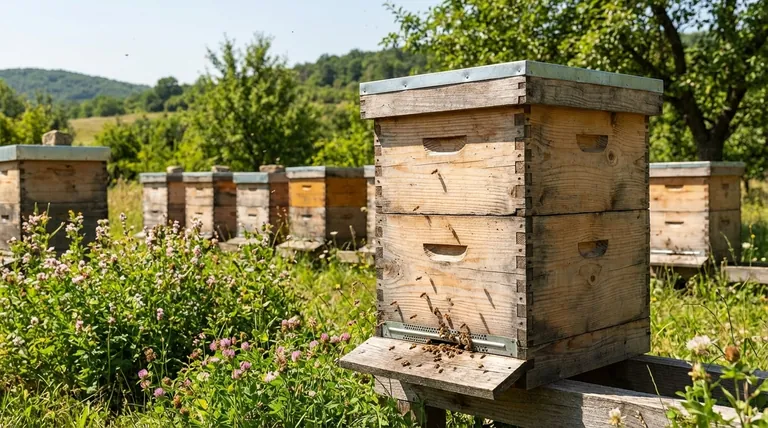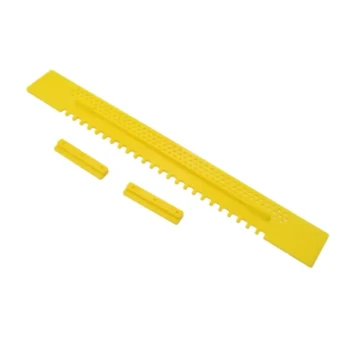In the context of temperature regulation, wooden hives offer superior breathability, which is crucial for helping bees manage internal moisture and humidity naturally. While plastic hives can provide better raw insulation, their non-porous nature traps moisture, creating a risk of condensation that can be detrimental to a colony, especially during winter.
The choice between wood and plastic is not a simple question of which is better at "temperature control," but a fundamental trade-off. You are choosing between wood's natural moisture management and plastic's superior insulation and durability, a decision that directly impacts your management style.

The Core Difference: Breathability vs. Insulation
The materials behave in fundamentally different ways. Understanding this difference is the key to selecting the right hive for your environment and beekeeping philosophy.
Wood's Natural Advantage: Moisture Management
Wood is a porous, natural material. This "breathability" allows water vapor, which the bees constantly produce through respiration, to slowly escape through the hive walls.
This process is critical for preventing condensation buildup. It helps the colony maintain a stable, healthy humidity level with less effort, reducing the risk of mold and moisture-related diseases like Nosema.
Plastic's Strength: Consistent Insulation
Plastic, particularly double-walled or foam-core designs, is a better insulator than wood. It has a higher R-value, meaning it's more effective at preventing heat transfer.
This can help bees stay warmer in the winter and cooler in the summer with less energy expenditure. However, this benefit comes with a significant challenge.
The Condensation Problem in Plastic Hives
Because plastic is non-porous, moisture has nowhere to go. In cold weather, the warm, moist air from the bee cluster rises and hits the cold inner surfaces of the hive, condensing into water droplets.
This condensation can drip back down onto the bees, chilling and stressing the colony at a critical time. A constantly damp environment is a primary driver of colony failure and disease.
Understanding the Practical Trade-offs
Beyond thermoregulation, the materials present very different challenges and advantages for the beekeeper.
Durability and Longevity
Plastic hives are impervious to rot and highly resistant to pests and weathering. They generally have a much longer lifespan with minimal upkeep compared to wood.
Wooden hives require regular maintenance, such as painting, to protect them from the elements and will eventually degrade from exposure to moisture.
Weight and Ease of Use
Plastic hives are significantly lighter than their wooden counterparts. This is a major advantage for beekeepers who need to move hives frequently or have physical limitations.
Flexibility and Repair
Wooden hive components are standardized and interchangeable. If a part breaks, it can be easily repaired or replaced. Wooden frames also allow for the use of any type of foundation.
Plastic frames, by contrast, often come with an integrated foundation. If they warp in extreme heat or break, they are typically impossible to repair and must be discarded.
How to Apply This to Your Project
Your choice should be guided by your local climate, your management style, and your overall goals as a beekeeper.
- If your primary focus is natural beekeeping or you live in a humid climate: Wood's breathability provides a crucial advantage for passive moisture control, creating a healthier internal environment.
- If your primary focus is durability and low maintenance in a climate with extreme temperatures: Plastic's superior insulation and weather resistance may be the better choice, provided you actively manage ventilation to prevent condensation.
- If your primary focus is managing many hives efficiently: The lighter weight and uniformity of plastic hives can drastically reduce physical strain and simplify your operations.
Ultimately, choosing the right material is about understanding that you are creating a system that must be managed to support the health of your bees.
Summary Table:
| Feature | Wooden Hives | Plastic Hives |
|---|---|---|
| Temperature Regulation | Natural breathability manages humidity | Superior raw insulation (higher R-value) |
| Moisture Management | Excellent; porous walls prevent condensation | Poor; non-porous walls risk condensation |
| Durability & Maintenance | Requires regular painting/maintenance | Highly durable, rot-resistant, low maintenance |
| Weight & Handling | Heavier | Lighter and easier to move |
Ready to equip your apiary with the right hives?
At HONESTBEE, we supply durable, high-performance beekeeping supplies and equipment to commercial apiaries and distributors. Whether your priority is the natural moisture management of wooden hives or the durable insulation of plastic hives, we have the wholesale solutions to support your colony's health and your operational efficiency.
Contact our experts today to discuss the best hive options for your specific climate and management style.
Visual Guide

Related Products
- Langstroth Bee Hives Bee Keeping Box for Beginners Beekeeping
- Australian Langstroth Beehive Boxes for Beekeeping Wholesales
- Langstroth Honey Bee Box Hive Boxes for Different Depths
- Wholesales Dadant Size Wooden Bee Hives for Beekeeping
- Professional Insulated Plastic Bee Hives
People Also Ask
- How does the ease of access differ between 8-frame and 10-frame hives? Choose the Right Hive for Your Body
- Why were wooden hives traditionally preferred? For Natural Beekeeping Aligned with Bee Biology
- Should a beginner try a different type of hive? Start with a Langstroth for a solid foundation.
- Why might a beginner be advised to start with a Langstroth hive? Unlock a Supportive Beekeeping Ecosystem
- What basic equipment is needed to start beekeeping? Your Essential Guide to a Confident Start



















